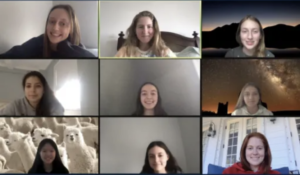Science fair. One of the greatest Hewitt traditions and the second most stressful time of the year (following March exams, of course). Every year, students rush to Staples in panic to purchase triple-fold boards and stick-on letters before they are all sold out. But is the stress worth it?
Especially this year, with half of the sophomores not participating in science fair (due to the 20/20 project) and with the event being held on the seniors’ second to last day of school, there was a lot of talk about who should be required to submit projects. The student body could not seem to reach a consensus- about half agree that all students should participate in and attend the fair while the other half think that it should be optional.
Ahmerie Shihade, Class of 2013, fell in the second group. “I feel it’s more of a middle school thing,” she said. “Once you’re in high school, it’s more beneficial to study theories and labs in class so that you have more time for discussion.” Maria Sabater, Class of 2013, added, “Little kids are better with hands-on projects. My little sister and all her friends love it. But, once you get to high school, you’re doing high-tech projects that can’t easily be tested. So you’re probably better off learning about them in class.”
Maria’s thinking can be backed up by several doctors and educational specialists who have studied the relationship between kids and hands-on learning methods. “Kids learn through their senses, and they like to touch and manipulate things,” says Ben Mardell, PhD. Educational consultant, Cindy Middendorf, says that “between the ages of four and seven, the right side of the brain is developing and learning comes easily through visual and spatial activities. The left hemisphere of the brain—the side that’s involved in more analytical and language skills—develops later, around ages 10 and 11.”

So does this mean that older students cannot benefit from hands-on activities any more than they can from PowerPoint presentations and class discussions? Maybe. But there is very little doubt that doing a hands-on experiment is much more fun. And when something is fun, it is often more memorable. Also, when students present projects at the science fair, they are able to share them with the family, friends, and faculty, widening the spread of knowledge and bringing the entire community together.
But there is more to the science fair that the educational aspect of it. The science fair is a sacred Hewitt tradition. According to Liz Dolgicer, Class of 2012, it’s “a right of passage.” Madeleine Mogul, Class of 2012, said, “Despite the science fairs notoriety as tedious, I think it is a nice tradition at Hewitt.”
In a school that is so concentrated on community, all should attend the science fair and support their peers despite their own participation (unless under extenuating circumstances). “The line is so gray,” Sarah Rodeo, Class of 2013, said. “I had a ballet recital that I could not miss, but I would have loved to be able to attend [the science fair]. I just think a lot of people skip it unjustifiably. There should be a clear and limited list of reasons as to why students are excused from the science fair to ensure maximum attendance. The more people, the more fun.”
The key word in Sarah’s statement is ‘fun.’ It is way too often that the purpose of science fair is lost in all of the last-minute board touch-ups and quest for community service hours (obtained by helping out with set-up or tear-down). The science fair is meant to foster entertainment, enjoyment, and knowledge, not stress and broken glue sticks. So next year, hold your head up high, and try double-sided tape! The science fair is here to stay.



Be First to Comment